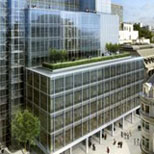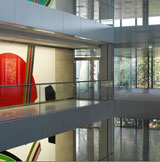Integrated Systems
Integrated, open systems are at the heart of today's networked world. PCs talk to PCs around the globe, scanners talk to printers, and cameras talk to PCs, while the complete IT infrastructure communicates on a common bus with common language.
Delmatic are leading international suppliers of integrated systems, providing energy-efficient control of lighting, HVAC and blinds, seamlessly joining products from various manufacturers and disciplines to optimise building operation.
Integrated building controls enable services – lighting, air-conditioning, heating, security, access-control and fire alarms – to interact using a common language across a common platform, respond in real time to occupants' needs and occupancy patterns, and be centrally managed and monitored through a single graphical user interface.
Integrated systems share key data – for example, a single sensor can relate lighting and heating/cooling to occupancy – and this pooling of information increases energy savings, enhances the efficiency of building services, and achieves operational savings over the life of the building. In addition, integrated systems share hardware, network infrastructure and buswiring, resulting in a lower installed cost.
click here to see how integrated systems work
Integrated open systems are about choice
Open systems offer multiple sources of supply, maintenance and support.
No longer must hardware, software and support be provided by a single supplier. Owners can mix-and-match open products that best suit their needs in function, design and cost, choosing from a variety of vendors and knowing that they will all communicate smoothly together using a common language. Products can be combined into a fully interoperable control network on a shared bus by a third party integrator using standard configuration software.
Open systems use open protocols that allow various manufacturers’ products to actively and interoperably communicate information on a common bus or network: the open protocol defines the messaging methods, media types, and requirements for devices to ‘coexist’ on the same wire.
Open systems are also about greater simplicity. By conforming to published standards, disparate devices from various manufacturers become instantly interoperable and can work seamlessly together on a network without needing gateways to translate data. Networks based on open standards lower costs and offer enhanced features not available in closed, proprietary systems.
Integrated open systems save energy
Open systems enable seamless integration with other energy-consuming building services including HVAC, so that both lighting and air-conditioning can be linked to occupation. To further optimise energy efficiency, temperature bands may also be related to occupancy with unoccupied areas operating under a wider temperature band: studies by ASHRAE (the American Society of Heating, Refrigerating and Air-Conditioning Engineers) show that a widening of the temperature band by one degree achieves 4% energy savings.
Integrated open systems save money
Open systems achieve major savings in both capital cost and over the life of the building.
Studies in the UK by Consultants Turner & Townsend and in the USA by CABA prove the installation and life-cycle cost benefits. Turner & Townsend designed and costed an 11,000 sq.m “virtual building” comparing the cost of services installation using proprietary systems with the installed cost of an open Lon system: the study shows a 4% saving per square metre when installing open Lon systems compared to a proprietary approach. CABA’s Integrated & Intelligent Building Council report shows a US$ 500,000 life cycle cost advantage when comparing fully integrated systems with proprietary systems for a 15,000 sq.m building.
Integrated systems – case studies
Open system technology enables Delmatic to integrate other building control products onto a shared lighting management network as well as allowing third-party integrators to integrate Delmatic products into their building networks. Delmatic have completed many projects where window blind controllers and HVAC controllers from other vendors have been seamlessly integrated onto a shared lighting management network, configured through Delmatic software and monitored through the Delmatic graphics package.
 Drapers Gardens London, UK |
 Roche HQ Welwyn, UK |
 ADIA Headquarters Abu Dhabi, UAE |
Delmatic have also supplied hardware to projects where system integration with other services, configuration and graphical monitoring of the lighting management hardware was by third party integrators using their own software and graphics tools.
 Cantonment HQ Singapore |
 DAFZA Dubai |
 Pfizer Research HQ Sandwich, UK |

Integrated systems optimise building efficiency by sharing data (so that all energy-consuming services are linked to occupation and other environmental factors such as daylight), by sharing cabling and hardware (which reduces cost and environmental impact), and offering clients multiple sources of supply and support.
